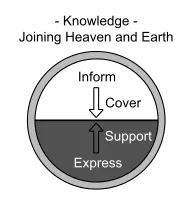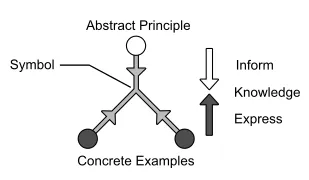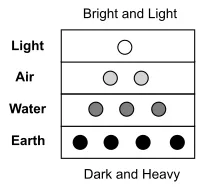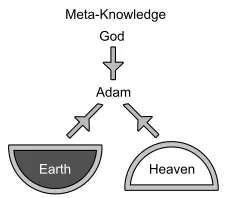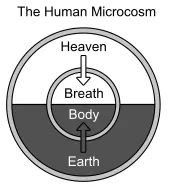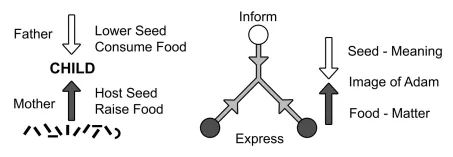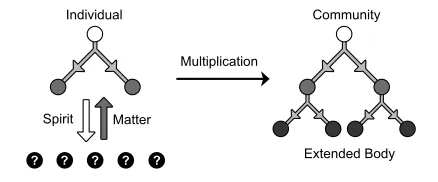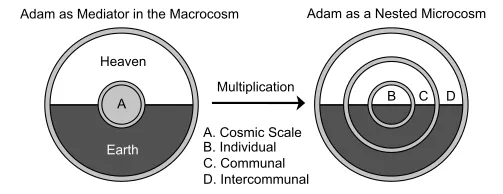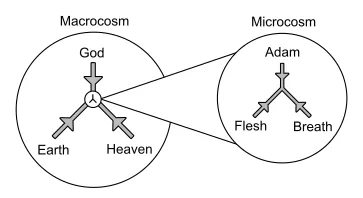Heaven and Earth
In the beginning, God created the heaven [spiritual meaning] and the earth [physical expression]
When considered from an ancient human perspective, the words ‘heaven’ and ‘earth’ refer to the two halves of the cosmos. This polarity completely encompasses reality, which makes it the secondary cause of all manifestation. In other words, everything in this universe was made from a combination of ‘heavenly’ and ‘earthly’ components.
In the Bible, raw ‘earth’ refers to matter without meaning, and pure ‘heaven’ refers to spiritual meaning without corporeal existence.
According to the spiritual worldview, the whole universe can be described in terms of the intercourse between ‘heaven’ and ‘earth.’ This joining of spiritual and corporeal realities–called knowledge–is the most fundamental notion in biblical cosmology. In fact, every single phenomenon can be interpreted according to this pattern.
As illustrated in the diagram above, the union of heaven and earth involves a dual interaction, in which the heavens “cover the earth” and the earth “supports the heavens.” On one end, spiritual reality informs corporeal reality with meaning and purpose. On the other end, matter expresses spirit by making it visible and tangible in the universe.
Symbolic Representation
In the beginning, God created the heaven [abstract principles] and the earth [concrete examples]
The image above illustrates the most basic pattern of symbolic representation. It shows the process of knowledge as the union of an abstract principle with a set of concrete examples. This simple cognitive structure is the key to understanding all ancient symbols.
Layers of Vertical Space
from Genesis 1:2
- Earth: The earth was meaningless and confounding.
- Water: Darkness was on the face of the deep.
- Air: The wind (spirit) of God hovered over the face of the waters.
- Light: God said, “Let there be light,” and there was light.*
*_Until recently, the only known source of light was fire. So, the narrative of creation suggests the following layers in its cosmology: earth, water, air, and fire.
Humans as a microcosm
God created the human in his image; in the image of God, he created him
According to biblical cosmology, the function of human beings is to act as a mediator between heaven and earth for the knowledge of God within creation.
The notion that Adam is “in the image of God” means that humanity is a symbol of the Creator within creation. Thus, Adam is the embodiment of divine knowledge in the world. Unlike regular knowledge, which involves the union of spirit and matter for created things, this type of knowledge transcends itself into a form of meta-cognition. The following diagram represents the ultimate pattern of interpretation in the Bible. Although it is similar to the patterns discussed in the previous section, this structure involves an infinitely higher level: the knowledge of God in creation.
God formed the human from the dust of the ground [earth] and breathed into his nostrils the breath of life [heaven].
In the story of The Garden of Eden, humanity is described as a microcosm of creation. Thus, Adam is created by joining a body from the earth and a breath from heaven.
Adam’s mediation between heaven and earth involves “lowering meaning” and “raising matter.” This cosmic process is symbolized in a variety of ways in the context of the Bible. For instance, Adam’s first job in the Garden of Eden is to name the animals, which is a clear case of “lowering heaven into the earth.” In this scenario, heaven’s wind becomes Adam’s breath and serves as a vehicle to communicate between spiritual and corporeal realities. With it, Adam is able to assign a spiritual identity to the animals of the world.
Naming Animals
from Genesis 2:19
God formed, from the ground, every beast of the field and bird of the air. He brought them to the human to see what he would call them. Whatever Adam called each living creature was its name
Language is what separates humans from animals in this cosmology. Adam is the only earthly creature capable of uniting spiritual principles and corporeal facts with language (through his spirit or breath).
The role of Adam towards animals is to name them and eat from them. It is important to understand that eating and naming are closely related in biblical cosmology. They are both examples of putting matter under the influence of your spiritual authority. Thus, naming, eating, and taming the animals are connected in meaning, and so are hosting, feeding, and following the angels.
Hosting Angels
from Genesis 18:1-10, Judges 13, etc…
The Lord appeared again to Abraham near the oak grove belonging to Mamre…
The role of Adam towards angels is to host them and feed them.
It is now important to understand that eating and naming are closely related in biblical cosmology. They are both examples of putting matter under the influence of your spiritual authority.
Reproduction
God created the human in his image, in the image of God he created it, male [heaven] and female [earth] he created them.
To truly grasp the significance of gender in the Bible, it is important to understand that Adam is the union of heaven and earth at the cosmic level, and that this union translates into a sexual union at the human level. Therefore, the male and female sides each represent one half of the equation. The male is responsible for materializing meaning into seed, and the female is responsible for refining matter into food.*
On one side of the equation, the father produces the seed that implicitly contains the essence of humanity. Therefore, the role of the male is directly connected to heaven and language. On the other side of the equation, like the earth itself, the mother provides sustenance in the form of food. In particular, she raises food from her own body, first in the womb and then in the breast.
*There is traditionally a strong connection between digestion and gestation because the womb is associated with the belly. Therefore, the seed apparently develops where the mother’s own food is being stored
Multiplication
God blessed them and said, “Be fruitful, multiply, and fill the earth.”
In the context of creation and the Garden of Eden, the word “Adam” simultaneously refers to an individual and humanity at large. Such interpretations are possible because Adam is the principle of the entire human race which is multiplied by a male-female dichotomy. As a result, humanity or “Adam” can increase the size of his “body” to populate the entire world.
Patterns at Scale
In biblical cosmology, the universe is a series of embedded representations of its cosmic principles. Therefore, every single word in the language of creation has a meaning that crosses multiple levels of reality, from the universal to the particular. In other words, the symbols of this language are neither metaphors nor similes, but words that point at once to different scales of organization.
The vocabulary of the language of creation can be interpreted at the cosmic scale and a variety of human scales. Thus, cosmic concepts like ‘heaven’ and ‘earth’ are translated into spirit and body, where they equally apply to individuals, nations, and empires, with implications that cross many levels of interpretation.
Learning to perceive the universe in terms of microcosms is a necessary step towards rediscovering the spiritual worldview.
Limits
Too Much Heaven (Meaning)
Too Little Earth (Matter)
Too Much Earth (Matter)
Too Little Heaven (Meaning)
Word Associations
| Heaven | Earth |
|---|---|
| Meaning | Matter |
| Abstract Principle | Concrete Examples |
| Inform | Express |
| Light | Dark |
| Day | Night |
| Light | Heavy |
| Air | Water |
| Wisdom | Understanding |
| Gold | Iron |
| Babylon | Rome |
| Breath | Body |
| Bread | Meat |
| Manna | Quail |
| Angels | Animals |
| Male | Female |
| Seed | Food |
